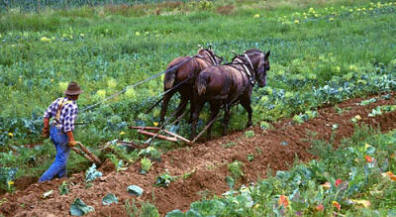|
Freedom to Fail
How U.S. Farming Policies Have Helped Agribusiness And Pushed Southern Farmers Toward Extinction

George Stylerís family traveled to Sullivan County, Tennessee from England in the 1880s. They farmed on other people's land until 1919 when they bought their own farm. Now, in face of a growing farm crisis, George Styler is battling to keep his family's 560-acre farm alive. "Now that prices have gone to heck, we're not getting any money at all," Styler says. "We don't buy anything we don't need." Styler's experience is typical of most Southern farmers who have been sold down the river by a calculated U.S. farm policy that directly benefits large agribusiness companies and factory-style farming at the expense of Southern family farms. The Southern farm crisis has hit home literally, with plunging farm prices -- the bane of family farmers for centuries -- forcing most farm families to work off the farm to survive. According to the U.S. Department of Agriculture, almost 90 percent of the total income of Southern farmers now comes from outside earnings. The driving force behind U.S. farm policy is the 1996 seven-year farm program titled the Federal Agricultural Improvement and Reform Act -- with the ironic acronym (FAIR). The bill, dubbed "Freedom to Farm" by its bipartisan proponents, put an end to the New Deal system of production controls and eliminates federal price supports. It provides farmers with a guarantee of fixed but declining payments to end in 2002, and allows flexibility to plant whatever they like. Prior to Freedom to Farm, if the price for a market commodity -- such as soy, wheat or corn -- dipped below the price floor, the government would cover the difference, thus ensuring that price wouldn't fall below the cost of production. Freedom to Farm eliminated price floors and removed "production controls" including land set asides and farmer-owned grain reserves. By giving farmers some ability to limit the amount of commodities on the market, these policies had given farmers some control over the price for their crops. Finally, the FAIR legislation gradually transitions away to the point of eliminating farm programs after the year 2002. The effects of Freedom to Farm have been immediate and devastating. Proponents touted the program as a way to increase exports and the price of crops. But "Freedom to Farm" has failed miserably on both accounts. Exports of corn, wheat, soybeans and sorghum have dropped by nearly 10 percent since enactment of Freedom to Farm. More importantly, prices have collapsed, with corn going from $3.24 a bushel in 1995-1996 to $1.90 in 1999-2000, wheat dropping from $4.55 to $2.50, soybeans declining from $6.72 to $4.70 and sorghum plummeting from $3.19 to $1.60. The policies of Freedom to Farm have been such an unmitigated failure that Congress has had to appropriate massive bailouts in each of the last three years to keep farmers on the land. In 1998, "emergency aid" to farmers totaled $15 billion. In 1999, it grew to $23 billion. Another $15 billion will be spent this year. Putting these numbers into perspective the total cost of farm programs in 1996 was $4.6 billion. Failed Policies, Flawed Assumptions Freedom to Farm was designed to expose farmers to the so-called free market. Freedom to Farm reduced the level of government interference, which in theory would allow farmers to thrive on the open market, particularly in what was seen as the growing export market. Freedom to Farm encourages fence-row-to-fence-row farming with no provision to control supply, and forces every bushel produced to be dumped on the market no matter how low prices are already depressed, since there is neither a fair loan rate nor a reserve program. Promoting the "free market" in farming was understood to translate into lower prices by removing price supports and production controls. Freedom to Farm has been derisively called "Freedom to Fail" by critics. Many agriculture experts believe the South has only a few years left to save its family farmers, before they are either swallowed up by larger farms, or left in financial ruin. The next farm bill, expected to be hashed out next year, will likely leave a lasting imprint on whether most Southern farmers will be able to stay on the land in the next century.

Self sufficient 'ish'.com - The urban guide to almost self sufficiency.
Tips for self sufficiency
|